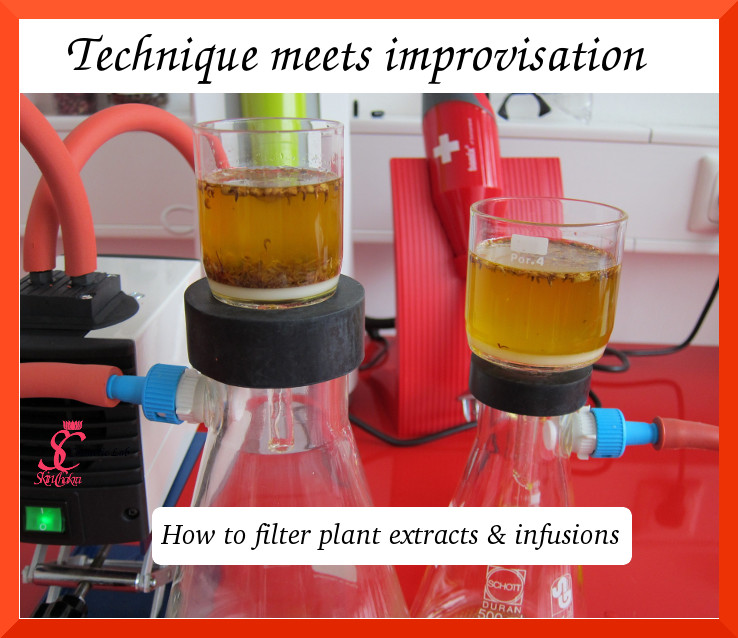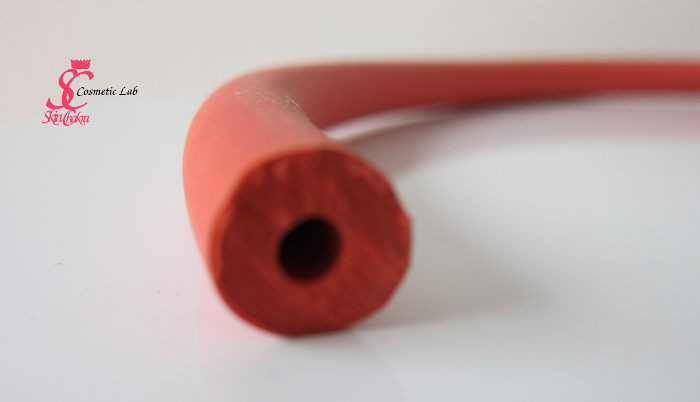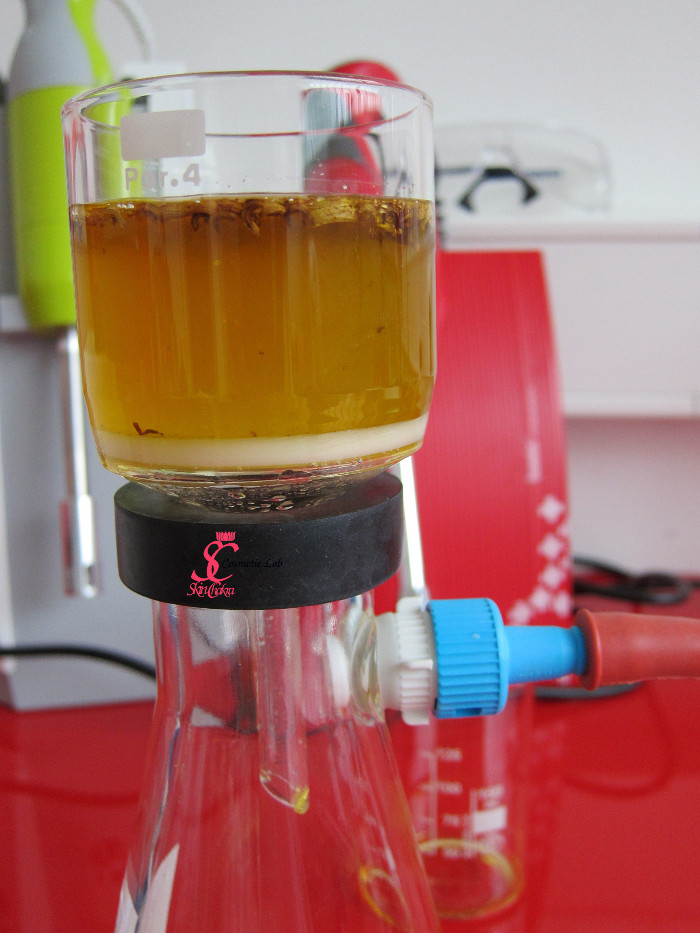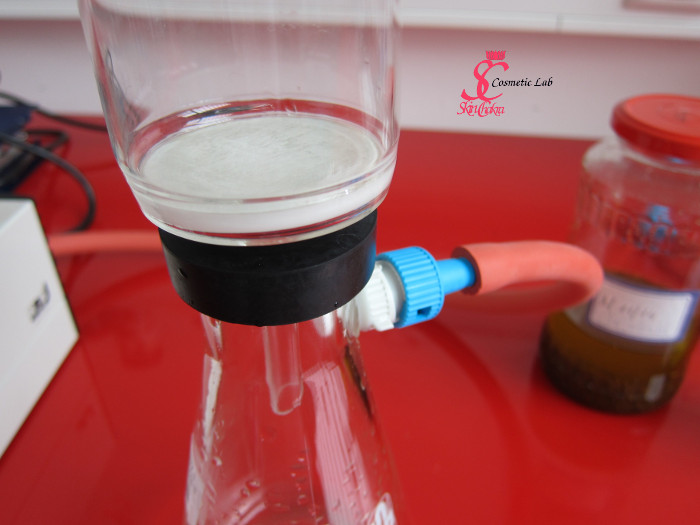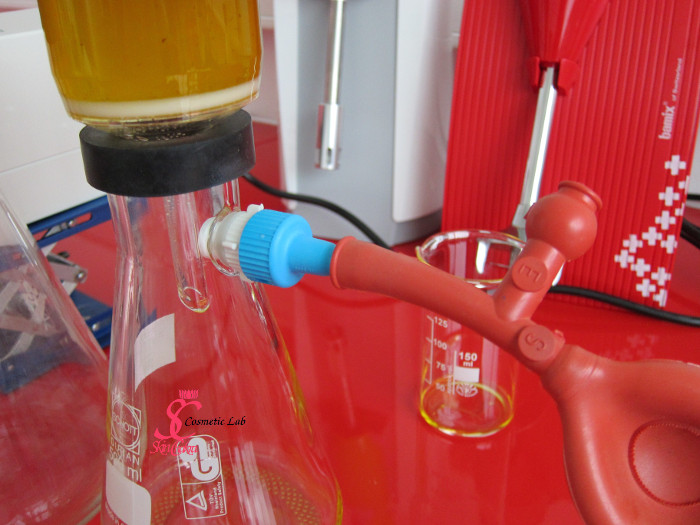Montag, 7. September 2015
How to filter your plant extracts, macerated oils and tinctures
One of the most troublesome and time consuming activities in the cosmetic lab is filtering plant extracts, infused oils, glycerites and tinctures.
Almost all instructions I have read recommend a coarse filtration with a stainless steel sieve and then a fine filteration with a cheese cloth, a coffee filter or a piece of cotton cloth attached to the jar mouth.
Well these methods would certainly work and the reason is hundreds and thousands of crafters and herbalists filtering their home made extracts in this way since decades.
I personally find these methods a little bit messy, non-hygienic and wasteful. Above all, they take almost an eternity.
In our cosmetic lab, we use vacuum filteration. By vacuum filteration you don't rely on gravity to pull the liquid through the filter, you apply vacuum (creating a negative pressure) to suck the liquid through the filter.
You have probably some experience with vacuum filteration from high school or from your general chemistry lab from the university (if you have had any chemistry lab).
Anyway, for vacuum filteration, you'll need a flask or a bottle with a side arm. This is a thick walled glass, not comparable to normal erlen meyer flasks. You'll need a funnel. You'll need some kind of washer or sealing between the funnel and the flask and you'll need a vacuum generator. And of course you'll need suitable hoses (vacuum tubes) to attach your vacuum source to the flask. These are thick walled hoses that do not collapse under vacuum.
One of the easiest ways to create vacuum (and this is the method we applied at the university) is to attach an aspirator to a water faucet. Look the this video for aspirator assembly and at this video for a full assembly of vacuum filteration.
Since we're going to filter plant extracts and our carriers are oils, glycerin, alcohol or a blend of glycerine-water and glycerine-alcohol, a filter paper would be too messy and wasteful. I prefer these fritted glass funnels with the integrated glass filter in them.
These are available in different funnel sizes and filter porosities. You can easily clean and disinfect them after each applicationa and you can even autoclave them. No mess, no waste of oil and carriers.
 Although we don't have any water deficiency in Germany, I personally could not bring it over my heart to apply water as the vacuum source. If you have no problem with wasting a few litres of water per filtration, then it would be one of the easiest and least expensive ways for a fast, hygienic and non-messy filtration of your plant extracts and macerations.
Although we don't have any water deficiency in Germany, I personally could not bring it over my heart to apply water as the vacuum source. If you have no problem with wasting a few litres of water per filtration, then it would be one of the easiest and least expensive ways for a fast, hygienic and non-messy filtration of your plant extracts and macerations.
I decided to apply a vacuum pump and use a mini vacuum membrane pump for my filtrations. You can see the mini vacuum pump on this phot at the left side of the photo.
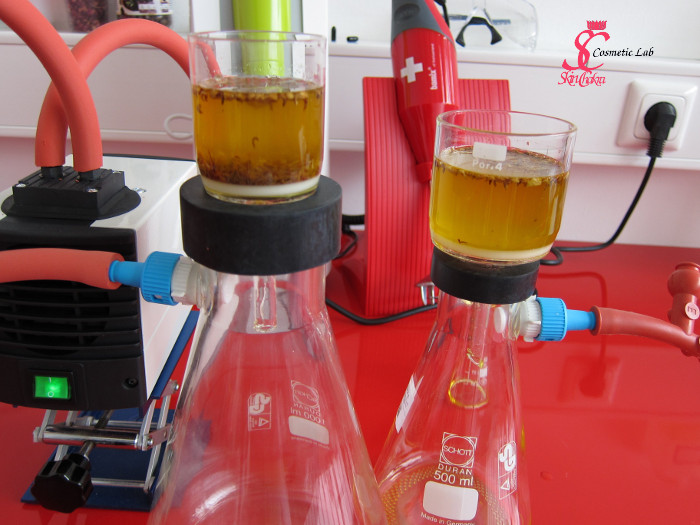 A vacuum pump is probably not on your highest priority list as you equip your lab. Besides a vacuum pump and aspirator vacuum, my dear friend Heike Käser from Olionatura has an amazingly simple suggestion to create vacuum for filtering plant extracts and infused herbs. Heike is without any doubt the DIY queen in German speaking countries. She tries to find some easy, cost effective and applicable ways of blending ingredients for her readers and followers, most of them working from their kitchens and home labs. I could never come to this amazing solution. She applies a simple and affordable pipette filler to create the negative pressure (partial vacuum) for filtration.
A vacuum pump is probably not on your highest priority list as you equip your lab. Besides a vacuum pump and aspirator vacuum, my dear friend Heike Käser from Olionatura has an amazingly simple suggestion to create vacuum for filtering plant extracts and infused herbs. Heike is without any doubt the DIY queen in German speaking countries. She tries to find some easy, cost effective and applicable ways of blending ingredients for her readers and followers, most of them working from their kitchens and home labs. I could never come to this amazing solution. She applies a simple and affordable pipette filler to create the negative pressure (partial vacuum) for filtration.
This method is certainly not as fast as the vacuum filtration by water-vacuum or a vacuum pump but is as effective and hygienic as any of these methods.
In this video, Heike explains how to apply the pipette filter for vacuum filteration. The video is in German but the demonstration is quite clear.
I hope you can test this method and would be convinced of its advantages over the traditional filtration methods.
Safety recommendations:
After I published this blog post, a great scientist, Titus Stoibish from LUM has mentioned some important safety recommendations I have totally neglected because they were obvious to me:
1- Vacuum is always accompanied with the risk of implosion. Make sure all your glassware is intact and has no cracks and without any fault. Even the slightest fault might cause an implosion. In best case, you have to clean up a great mess and glass splitters.
2- DO NOT FORGET YOUR SAFETY GOGGLES
3- Put a shield between yourself and the assembled filtration.
Now please don't run into panic and think you'll need any Don Quixote armour to run a simple filtration. I'm running vacuum filtration since years and even during those carelss university time have never experienced any implosion. But safety is first and according to Murphy's law: If anything can go wrong, it will
Wish you safe and fun vacuum filtrations.
BeHappy and have fun
